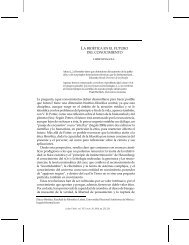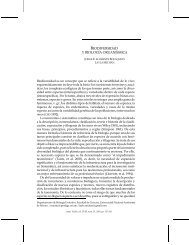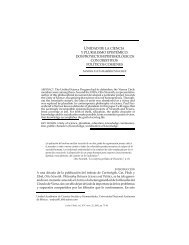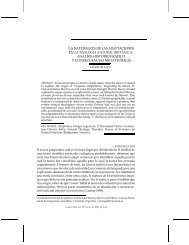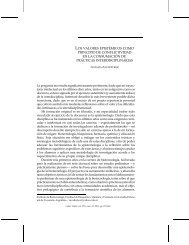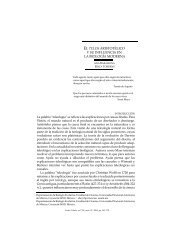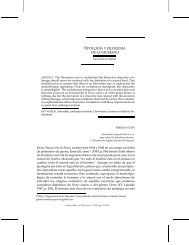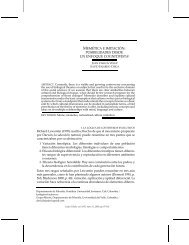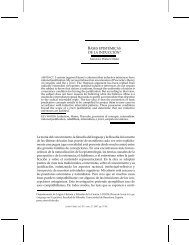origen del lenguaje: un enfoque multidisciplinar - Ludus Vitalis
origen del lenguaje: un enfoque multidisciplinar - Ludus Vitalis
origen del lenguaje: un enfoque multidisciplinar - Ludus Vitalis
You also want an ePaper? Increase the reach of your titles
YUMPU automatically turns print PDFs into web optimized ePapers that Google loves.
140 / LUDUS VITALIS / vol. XVII / num. 31 / 2009Merani , A. (1960), Mano, cerebro y <strong>lenguaje</strong>, Mérida, Venezuela: Imprenta Universitaria.Mercier, N. (2001), Palabras y mentes. Barcelona: Paidós.Miller, G. A. (1985), Lenguaje y habla. Madrid: Alianza.Mora, F. (2001), El reloj de la sabiduría. Tiempos y espacios en el cerebro humano.Madrid: Alianza.Newport, E. L. (1990), “Maturational constraints on language learning,” CognitiveScience 14: 11-28.Piaget, J. (1973). El <strong>lenguaje</strong> y el pensamiento en el niño. Buenos Aires: Guadalupe.Pike-Tay, A. y Knecht, H. (1993), “La caza y la transición <strong>del</strong> Paleolítico Superior”,en V. Cabrera (ed.), El <strong>origen</strong> <strong>del</strong> hombre moderno en el suroeste de Europa. UNED:Madrid.Pinker. S. y Bloom, P. (1990), “Natural language and natural selection,” Behaviouraland Brain Sciences 13: 707-784.Pollick, A. S. y. de Waal F. B. M. (2007), “Ape gestures and language evolution,”PNAS 104 (19): 8184-8189.Premack, D. (1971), “Language in chimpanzee?”, Science 172: 808-822.Premack, D. y Woodruff, G. (1978), “Does the chimpanzee have a theory ofmind?”, Behavioral and Brain Sciences 1: 515-526.Premack, D. y Premack, A. (2002), Original Intelligence. New York: McGraw-Hill.Rabbit, P. (1997), Methodology of Frontal and Executive F<strong>un</strong>ction. London: PsychologyPress.Rakic, P. (1988), “Specification of cerebral cortical areas,” Science 241: 170-6.Rakic, P. (1995), “Evolution of neocortical parcellation: The perspective fromexperimental neuroembryology,” in Changeux, J. P. y Chavaillon J. (eds.).Origins of the Human Brain. Oxford: Clarendon Press, pp. 85-100.Ramírez-Goicoechea, E. (2005), “Orígenes complejos de la conciencia: hominizacióny humanización”, en L. Álvarez M<strong>un</strong>árriz (ed.), La conciencia humana:Perspectiva cultural. Barcelona: Anthropos, pp: 93-135.Rensch, B. (1983), Homo sapiens. De animal a semidiós. Madrid: Alianza.Rilling, J. K., e Insel, T. R. (1999), “The primate neocórtex in comparative perspectiveusing magnetic resonance imaging,” Journal of Human Evolution 37:191-223.Rivera, A. (1998), “Arqueología <strong>del</strong> <strong>lenguaje</strong> en el proceso evolutivo <strong>del</strong> géneroHomo”. Espacio, Tiempo y Forma. Serie I, Prehistoria y Arqueología 11. Madrid:UNED.Rivera, A. (2004), “Arqueología cognitiva. Una orientación psicobiológica”, ArqueoWeb6 (1). Universidad Complutense de Madrid. URL: http://www.ucm.es/info/arqueoweb/index.htm.Rivera, A. (2005), Arqueología cognitiva. El <strong>origen</strong> <strong>del</strong> simbolismo humano. Madrid:Arcos/LibrosRivera, A. (2007), “Evolución y conducta”. ArqueoWeb 9 (1). Universidad Complutensede Madrid. URL: http://www.ucm.es/info/arqueoweb/index.htm.Rivera, A. (2007a), “Relación entre neandertales y cromañones: Un <strong>enfoque</strong>cognitivo”. Zephyrus, LX, (en prensa).Salguero Lamillar, F. J. (2004), “Enfoque modular, sí; internista, no tanto”, <strong>Ludus</strong><strong>Vitalis</strong> XII (22): 179-181.Schlaug G.; Knorr, U. y Seitz R. J. (1994), “Inter-subject variability of cerebralactivations in acquiring a motor skill. A study with positron emission tomography,”Experimental Brain Research 98: 523-534.



